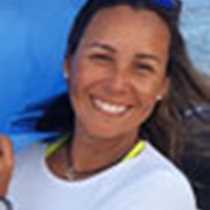Bartolomé and Rabida
On our first full day into our expedition, we woke up to the stunning landscapes of Bartolomé. A small island off the eastern coast of the big island of Santiago, it retains many geological features of its volcanic origins. On a pre-breakfast outing, we set off to hike to the summit of Bartolomé. A long wooden boardwalk that includes some 370 steps, it takes us through cindery slopes, spatter cones, and a marvelous ‘moonscape.’ At the top we were rewarded with one of the most famous landscapes of the Galápagos Islands: that of the Pinnacle Rock standing by a golden beach, surrounded by a stretch of blue waters and the black lava fields of Sullivan Bay.
After breakfast and collecting our snorkeling gear for the week on board, we set off towards the beach of Bartolomé. The timing was perfect as the early morning clouds had cleared out and now we had some equatorial sunshine. Bartolomé Island has lots of beautiful volcanic landscapes, but it’s also the home to several endemic species found only in the Galápagos. Amongst them we find the ever-popular Galápagos penguin. Here a small population has been established for a long time, and since the fish supply seems plentiful today we could observe several individuals pretty busy chasing their prey! A sleepy Galápagos sea lion dozed on the side of the beach, while a great blue heron was fishing in the shallow waters, hopefully with success.
Towards midday, we had to come back on board. It had been a busy morning already, and on schedule we had a special treat: our typical Ecuadorian lunch. It was a real feast, and to follow the tradition, many of us took a short Ecuadorian ‘siesta’ during the navigation to Rabida.
The island of Rabida is located in the central part of the archipelago. From the distance, it looks reddish, due to the iron oxide that already shows on its old lavas. The conditions this afternoon were perfect for some of us to practice some kayaking along the rocky shores, where nesting pelicans and endemic marine iguanas were on sight. Our fearless snorkelers were amazed by the huge schools of pink cardinal fish and striped salemas, a sign of the highly productive waters of this archipelago. Pacific green sea turtles and marine iguanas feed on seaweed, which is quite abundant here, and we were very lucky to have seen them underwater. Rabida is the home to a small population of Galapagos sea lions, some of which were resting on the beach. After landing on the red beach, a short trail leads us to a viewpoint overlooking the bay. The yellow light of the sun setting behind the National Geographic Islander revealed the spectacular colors of the area. It was and unforgettable day, and this is just day two into our expedition in this isolated corner of the planet.




